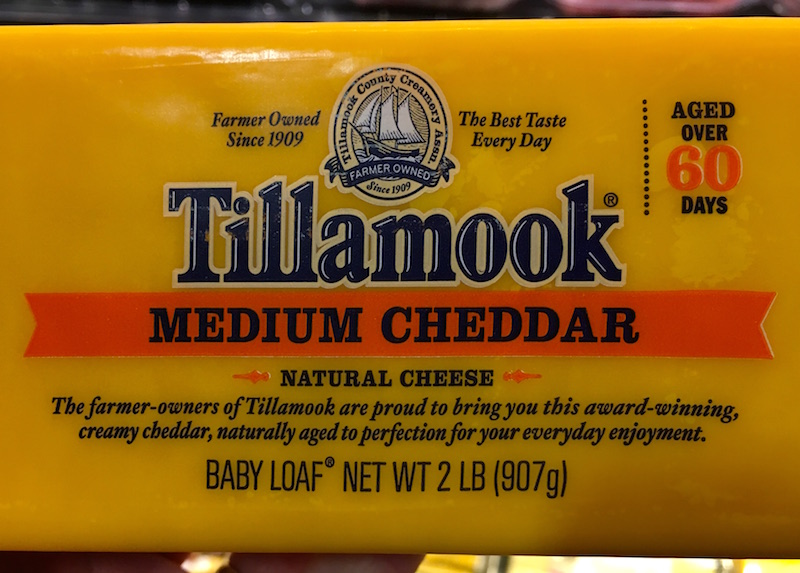
Why I'm Quitting Tillamook Cheese
"As Oregonian as a lumberjack sharing a craft beer with a beaver,
no one does cheese like Tillamook."
- New Seasons sale flyer
Their packaging says "Thank you for buying Tillamook and keeping our family farms strong."
Since childhood I've been a fan of Tillamook cheese. Molten and gooey inside grilled cheese sandwiches, grated into mac and cheese and melted over just about anything you can think of, its bright orange hue has been a color theme weaving through my life. On trips to the coast my parents would stop the station wagon at the cheese factory to follow the steps that the milk took from liquid to curd to sliced chunks which were finally pressed into logs, aged and dipped in wax (now wrapped in plastic) to be displayed on refrigerated shelves.
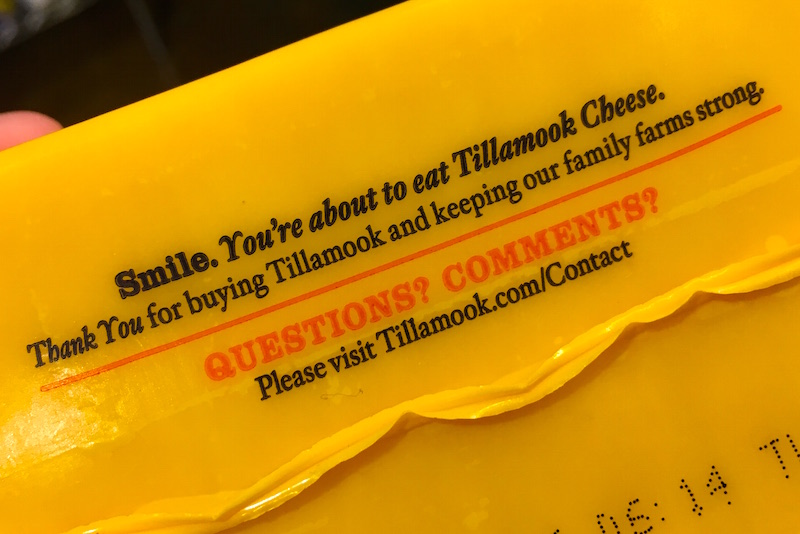
On those same trips my parents would point out the cows munching grass in the brilliant green coastal pastures of Tillamook County, their pendulous udders swaying as they moved to the barns to be milked twice a day. "That's where our cheese comes from!" we'd think.
That's why it is with a heavy heart that I've finally decided to give up Tillamook cheese. It's not because the flavor has somehow fallen off of a cliff, or that I've discovered a better product—their extra sharp white cheddar had become our house cheese after my husband developed an intolerance to lactose. (Lactose is converted to lactic acid by cultures added to the cheese, and the longer it's aged, the less lactose remains.)
So why have I reached this decision?
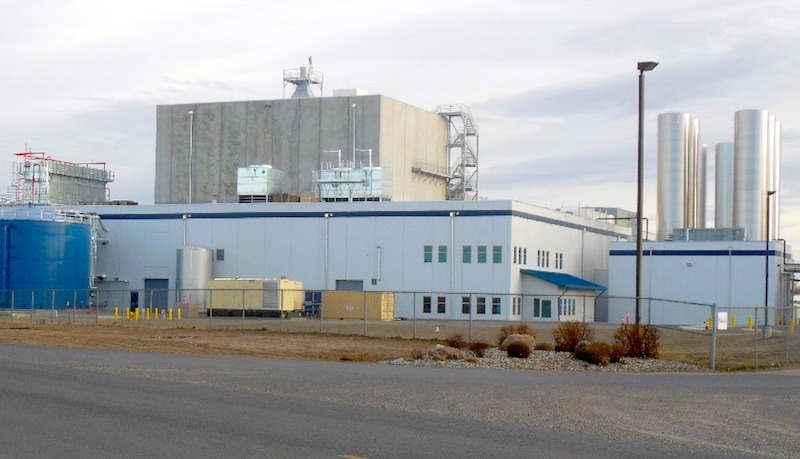
It turns out that only a portion of the milk that is used by the Tillamook County Creamery Association (TCCA)* to make their famous cheeses is produced by those cows munching that rich, coastal grass. Instead, Tillamook has partnered with Threemile Canyon Farms in Boardman on the Columbia River, a factory farm that produces around 2 million pounds (that's 233,000 gallons, folks) of milk per day from 30,000 milk cows kept during the entirety of their short lives in confined barns. Add to that another 40,000 animals consisting of calves and "replacement heifers," young females that will be added to the milking herd at two years old.
As for the amount of milk produced in Tillamook County itself, a report from 2014 titled "Tillamook County Community Food Assessment: Growing Healthy Communities on the North Oregon Coast" noted that at that time "the cooperative…gets more than half its milk from outside Tillamook County and does a portion [of its] other cheese making and distribution from Boardman, Oregon." [A subsequent lawsuit against the TCCA for false advertising claims states the amount of milk supplied by the mega-dairies in Boardman is more than 80 percent of the total.]
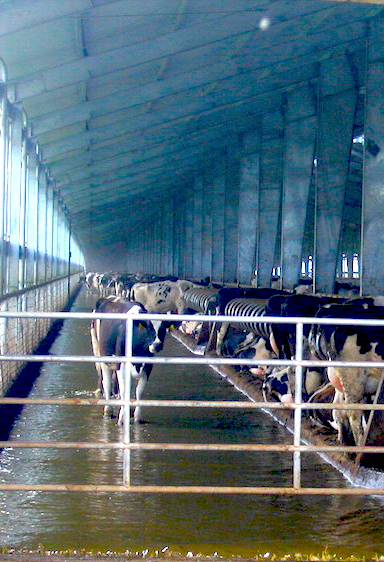
An article in the Tillamook Headlight Herald from 2012, announcing layoffs of 50 employees doing packaging at the Tillamook processing facility—outsourced to companies in Utah and Idaho—quoted then-TCCA CEO Joe Rocha as saying that "all ice cream is made in Tillamook. Other Tillamook brand products, such as yogurt, butter and sour cream, are licensed products produced by other companies. All local milk is processed in Tillamook."
Tillamook has also built a large cheese processing facility, Columbia River Processing, near Threemile Canyon Farms in Boardman that was designed to produce 58 million pounds of cheese a year at full operation. In 2014 it built a 64,000-square-foot expansion project to process whey, which is used in products like infant formula, performance nutrition products and products that "help manage some of the impacts of aging."
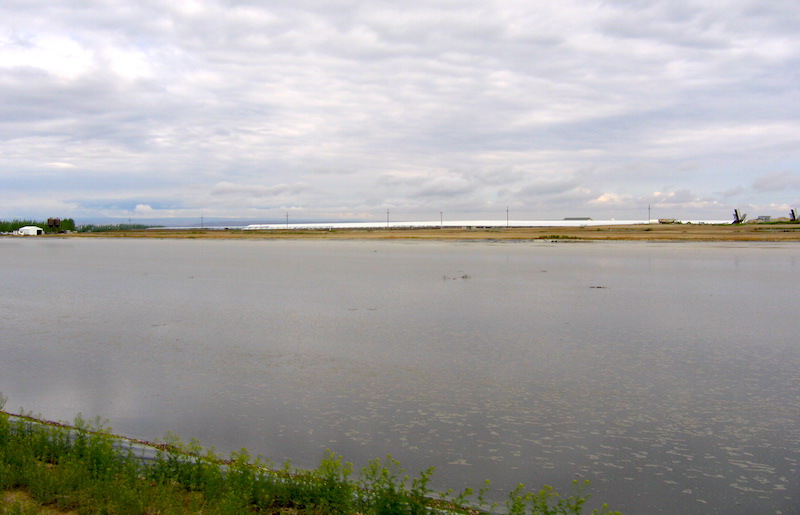
According to an article in the East Oregonian, the system is a "closed loop" where the milk cows "are loaded onto slowly rotating carousels where their udders are sprayed with a disinfectant and attached to automatic pumps. Each spin lasts just a few minutes before the cows are unloaded back where they started." The rest of the loop is made of the waste from the 70,000 animals—estimates are around 436 million gallons of liquid manure every year—that go into digesters and open lagoons that is then spread on fields of grain corn and triticale which is used to feed the cows or is made into animal bedding.
The manure spread on the fields is supposed to be carefully managed to avoid having the runoff pollute area groundwater, but an article on another proposed mega-dairy in the area, Lost Valley Farm, reports that it would add an additional 30,000 dairy cows and their waste to the already beleaguered groundwater system in the county. "The area is home to the Lower Umatilla Basin Groundwater Management Area, where the level of nitrates in the groundwater already exceeds the federal safe drinking water standard," the article notes.
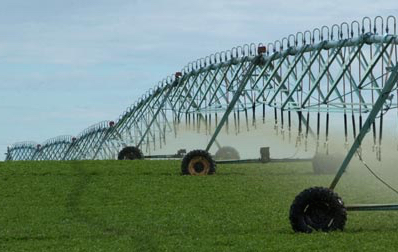
There are also concerns about air pollution, and groups like the Center for Food Safety, Friends of Family Farmers and the Socially Responsible Agriculture Project are pushing for new rules to regulate air contaminant emissions (SB197) from large dairy operations. In 2007, Oregon exempted large-scale livestock operations from air-quality oversight, even though elevated concentrations of ammonia from Threemile Canyon Farms have been linked to acid deposits in the Columbia River Gorge, and nitrogen compounds are contributing to elevated levels of ozone in the vicinity of these operations.
The nail in the coffin was driven in, for me, when I started to look into what these mega-dairies were doing to Oregon's small, family-owned dairy farms. As Jon Bansen, a third-generation dairyman who is hoping to someday turn his farm over to his son, wrote in an editorial in the Salem Statesman-Journal, "when the last mega-dairy, Threemile Canyon Farms, came into Oregon, an average of nine family dairy farms went out of business per month between 2002 and 2007. Mega-dairies flood the market with milk, driving down milk prices and making it increasingly difficult for family farmers to stay afloat."
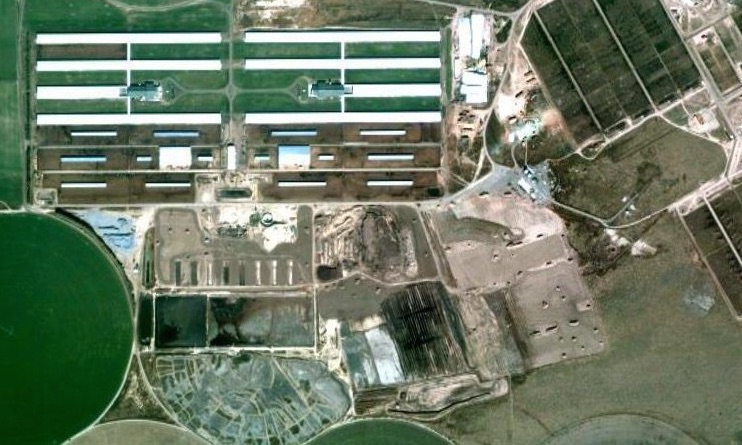
Mega-dairies also degrade the lives of local communities. Bansen goes on to say that "the ways in which family dairy farmers and mega-dairies contribute to a community are drastically different. When something breaks, family farmers typically buy parts from the local store. When their animals need veterinary attention, they call the local vet. They support their feed stores, tractor-supply stores and more. After a hard day on the farm, family farmers often engage in their community, schools, civic groups and churches." Employees at mega-dairies have neither the time nor the money to spend in their communities; equipment is bought from the cheapest (mostly non-local) sources; and profits are sent off to corporate, often out-of-state, offices.
So for all of these reasons I'm looking for a new, delicious source for my cheese, and I'll try to buy from small cheesemakers who source their milk from small, family farms. It'll no doubt be more expensive than the cheap-for-a-reason stuff, but I'm willing to spend a little more and use a little less if it helps to support local families and communities.
The Tillamook slogan is "Dairy Done Right." I disagree. How about you?
UPDATE: If I needed more assurance that my decision to stop buying Tillamook cheese was the right one, this past week the Oregon Department of Agriculture and the state Department of Environmental Quality both gave the go-ahead to Lost Valley Farm, a 30,000-cow mega-dairy in the Boardman area. A California-owned facility, Lost Valley joins North Dakota-based Threemile Canyon Farm in supplying milk that goes into making Tillamook cheese. According to a story in the Salem Statesman-Journal, "both dairies hold contracts with Boardman’s Columbia River Processing, which produces cheese for the Tillamook County Creamery Association, maker of Oregon’s famous Tillamook Cheese."
Lost Valley also had to gain the official approval of Morrow County's commissioners, although according to a story in the Oregonian, "the county [had] no legal way to stop what would be the state's second-largest dairy, and its three commissioners are deeply worried that it will sap already-limited groundwater from local farmers, and exacerbate water and air quality problems."
Since the county had no choice but to approve the facility despite deep misgivings, the article then asks, "that raises a crucial question for a coalition composed of local and federal government agencies, small farm advocates and environmental organizations: Are Oregon's rules for mega-dairies and livestock feedlots too loose?"
Ivan Maluski, Policy Director of Friends of Family Farmers, thinks so. "We've been warning for some time that Oregon's rules are too weak, and we're in danger of being a big factory farm state," he was quoted as saying. (Read an extended version of this update.)
UPDATE: As if I needed any more reinforcement of my decision to quit buying Tillamook products, a massive dairy sewage spill—more than 190,000 gallons—that flooded neighboring properties and entered the water systems that eventually run into Tillamook Bay has closed the bay to commercial shellfish production, according to an article in the Salem Statesman-Journal. This is the third time in the last month that dairy sewage has spilled from storage tanks or drainage ponds and caused fecal coliform readings hundreds of times higher than the standard allows. These leaks have been the subject of lawsuits on the part of local fish and shellfish operators, who often have to shut down for weeks or months twice a year during rainy periods when flooding can occur. The economic impact of this latest spill to individual fishing families and shellfish operators has not been estimated, but the cumulative effect of the shutdowns and spills to local fishing and farming communities over the years cannot be underestimated.
UPDATE: A recent column from Friends of Family Farmers outlines the effects of corporate agriculture in Oregon.
UPDATE: My article for Edible Portland on the dairies that supply milk to Tillamook, titled "Big Milk: Big Issues for Local Communities," expands on the topic of industrial agriculture's creeping influence in Oregon, challenging long-held traditions of our state’s agriculture as one based on small, family-scale farms.
UPDATE: Lost Valley Farm, mentioned above and one of the Boardman-area factory farms supplying milk to Tillamook, has been the subject of intense scrutiny due to owner Greg te Velde defaulting on loans, getting arrested in a prostitution sting operation and possessing meth, and a history of failure to maintain the standards set out in the facility's state permit. Read that story here.
* I contacted the Tillamook County Creamery Association Consumer Relations department for this post and was told they could not comment on the facts referenced in this post because "production numbers like the kind you are seeking are not figures that we generally share with the public."
Photos of cow barn and manure lagoon from Friends of Family Farmers. Photo of sprinklers from Threemile Canyon Farms website. Aerial photo from Google maps.